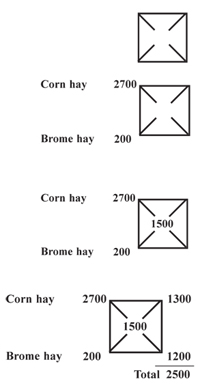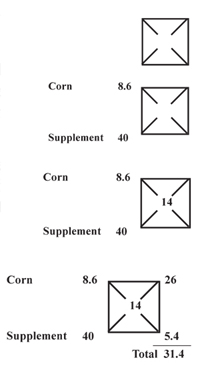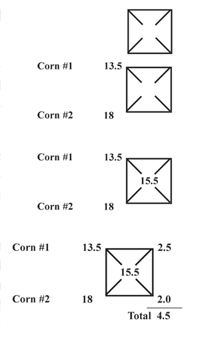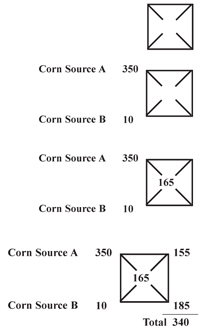G1500
Blending Grain and Feedstuffs — How to Figure the Proper Proportions
This NebGuide demonstrates how to use a Pierson square to determine the precise proportions of grain or feedstuff required to create a blend.
Thomas W. Dorn, Extension Educator
Duane E. Reese, Extension Swine Specialist
Bruce E. Anderson, Extension Forage Specialist
- Blending Feed Ingredients to Formulate a Diet
- Blending Grain to Achieve a Desired Moisture Content
- Blending Forage Sources to Achieve Acceptable Levels of Nitrate
- Blending Corn to Achieve Acceptable Aflatoxin Levels
- Proper Mixing Is Necessary for Successful Blending
- For More Information
- Acknowledgment
Blending Feed Ingredients to Formulate a Diet
|
Typically, diets are balanced for protein, one or more measures of energy, and minerals. To keep the discussion on a basic level we will balance a swine diet on a crude protein basis using corn as the primary ingredient and a commercial supplement as a source of protein, vitamins, and minerals.
Assuming corn contains 8.6% crude protein (as-fed) and a complete commercial supplement contains 40% crude protein (as-fed), formulate a swine diet containing 14% crude protein (as-fed).
-
Draw a square with diagonal lines connecting the corners.
- Write the name of each ingredient and its protein content beside the upper and lower left-hand corners, respectively.
- Place the desired protein level of the diet at the intersection of the diagonal lines in the center of the square.
- Subtract diagonally through the square. That is, subtract the upper left-hand value from the desired value (center value) and report the absolute value of the difference beside the lower right corner. Subtract the lower left-hand value from the desired value and report the absolute value of the difference beside the upper right corner. Then add the right-hand values to find a total.
- Divide each right-hand value by the total and multiply by 100 to covert from a decimal to a percentage. The result in the upper-right represents the percentage of corn needed in the diet. The result in lower-right represents the percentage of supplement needed in the diet.

Answer: The final diet should be 82.8% corn and 17.2% supplement. Each ton should contain 2,000 x 0.828 = 1,656 lb corn and 2,000 x 0.172 = 344 lb of supplement.
| Check: | 1,656 lb x 8.6% = |
142.4 lb protein from corn |
344 lb x 40.0% = |
137.6 lb protein from the supplement | |
Total = |
280.0 lb protein per ton |
280.0 lb protein/2,000 lb of as-fed diet = 0.14 x 100 = 14% crude protein
Blending Grain to Achieve a Desired Moisture Content
A Pierson Square can be used to calculate how to blend two grain sources to achieve a desired final moisture content. Use the wet-basis weights of the two grain sources when formulating the blend.
|
Assume you have access to a drying bin (airflow greater than 1.0 cfm/bu) with a stirring system. Assume also that you have two sources of corn. Corn #1 has 13.5% moisture and corn #2 has 18% moisture. You want to create a blend with an average moisture content of 15.5%. You plan to run the stirring augers during filling and for at least two full rounds after the bin is full to uniformly blend the grain. How many pounds of each corn source should be blended to make 10,000 bushels (560,000 lb) of corn with an average moisture content of 15.5%?
-
Draw a square with diagonal lines connecting the corners
- Write the name of each ingredient and its moisture content beside the upper and lower left-hand corners, respectively.
- Place the desired moisture content of the blend at the intersection of the diagonal lines in the center of the square.
- Subtract diagonally through the square. That is, subtract the upper left-hand value from the desired value (center value) and write the absolute value of the difference beside the lower right corner. Subtract the lower left-hand value from the desired value and write the absolute value of the difference beside the upper right corner. Then add the right-hand values to find a total.
- Divide each right-hand value by the total and multiply
by 100 to covert from a decimal to a percentage. The result in the upper-right represents the percentage of
corn #1 needed to make the blend. The result in lower-right represents the percentage of corn #2 required in
the blend.

Answer: The final blend should be 55.6% of corn #1 and 44.4% of corn #2.
Or 560,000 lb x 55.6% = 311,360 lb of corn #1 and 560,000 lb x 44.4% = 248,640 lb of corn #2.
Check:
| Corn #1. | 311,360 lb @ 13.5% moisture =311,360 lb x 0.135 = |
42,034 lb water | |
248,640 lb @ 18% moisture = 248, 640 lb x 0.18 = |
44,755 lb water | ||
560,000 lb corn |
Total = |
86,789 lb water | |
Grain blend is 86,789 lb water/560,000 lb corn (wet basis) = 0.155 x 100 = 15.5% water.
If the corn is between 45° and 55°F going into the bin, an alternative procedure would be to create a 16.5% moisture blend initially. Once the grain is thoroughly blended, the stirring augers and aeration fan are turned off and the corn is allowed to temper for six to 10 hours. The aeration fan is then run to push a cooling/drying front through the grain. The goal is to cool the grain to 35-40°F and dry it to 15.5% final moisture. This method should result in better uniformity in moisture content throughout the grain mass than blending initially to the final moisture content.
Blending Forage Sources to Achieve Acceptable Levels of Nitrate
Drought reduces forage yield in pastures and range. Reduced pasture production increases demand for harvested forage as producers supplement cattle on pasture or bring them into dry lot feeding situations where they are fed harvested forage. Drought also reduces production of hay. Increased demand for harvested forage and reduced supply due to drought causes hay prices to increase. When hay prices increase sufficiently, cattle producers search for alternative forage sources.
Dryland grain yields are reduced in drought years. Sometimes crop producers can maximize net return by harvesting their crop as forage rather than grain, especially when forage prices are high and grain yield will be low.
Drought-stressed annual crops harvested as forage may contain high levels of nitrate and should be tested before feeding to livestock. Nitrate testing of feed is especially important in years where the crop has undergone stress, especially if high rates of nitrogen fertilizer or manure were applied, or if the soil has a high organic matter content.
Under most feeding situations, nitrate-nitrogen (NO3-N) levels over 2,100 parts per million (ppm) in feed are considered potentially toxic. Some laboratories report the concentration of nitrate (NO3) instead of nitrate-nitrogen (NO3-N). The potentially toxic level for nitrate is 9,000 ppm.
Feedstuffs testing high in nitrates can be used as a part of a ration if they are diluted in a blend with feeds containing lower nitrate levels. A Pierson square can be used to formulate a forage blend containing a level of nitrate that can be tolerated by the animals.
Assume a cattle producer has hay made from drought-stressed corn that tested 2,700 ppm NO3-N and brome hay that tested 200 ppm NO3-N. The producer wants to formulate a forage mix containing 1,500 ppm NO3-N to feed a herd of 74 cows. The cows will eat 27 lb of forage per head per day on an as-fed basis. 27 lb/head/day x 74 head = 2,000 lb total forage per day, as-fed.
-
Draw a square with diagonal lines connecting the corners.
- Write the name of each ingredient and its nitrate-nitrogen (NO3-N) content beside the upper and lower left-hand corners, respectively.
- Place the desired level of
NO3-N of the blend at the intersection of the diagonal lines in the center of the square.
- Subtract diagonally through the square. That is, subtract the upper left-hand value from the desired value (center value) and write the absolute value of the difference beside the lower right corner. Subtract the lower left-hand value from the desired value and write the absolute value of the difference beside the upper right corner. Then add the right-hand values to find a total.
- Divide each right-hand value by the total and multiply by 100 to covert from a decimal to a percentage. The result in the upper-right represents the percentage of corn hay needed in the blend. The result in lower-right represents the percentage of brome hay needed in the blend.

Answer: The final blend should be 52% corn hay and 48% brome hay.
Since the cattle producer in this example will be feeding a ton of forage per day, each day the producer should mix 2,000 lb x 0.52 = 1,040 lb of corn hay and 2,000 lb x 0.48 = 960 lb of brome hay to feed the cow herd.
| Check: | 1,040 lb corn hay x 2,700 ppm NO3-N = 2.81 lb NO3-N
960 lb brome hay x 200 ppm NO3-N = 0.19 lb NO3-N
Total = 3.00 lb NO3-N |
3.00 lb NO3-N/2,000 lb hay = 0.0015 x 1,000,000 = 1,500 ppm
Blending Corn to Achieve Acceptable Aflatoxin Levels
On rare occasions, following severely stressful growing conditions such as a drought, corn may become contaminated in the field with molds that produce toxic substances known collectively as mycotoxins. One mycotoxin of particular concern is aflatoxin. The United States Food and Drug Administration establishes action levels on the amount of aflatoxin that is allowed in corn intended for specific uses. In instances where corn contains more aflatoxin than is allowed for a specific use, it may be possible to reduce the amount of aflatoxin in the corn by blending it with corn found to have a lower level of aflatoxin or that is free of aflatoxin.
The Nebraska Department of Agriculture allows grain with high levels of aflatoxin to be blended with corn with lower levels of aflatoxin, or free of aflatoxin, provided the blended product is intended as animal feed to be fed to finishing beef cattle or to finishing swine weighing more than 100 pounds. The following requirements must be met: The grain producer or user must resample and test for aflatoxin to certify that the blend does not exceed 300 parts per billion (ppb) for finishing cattle or 200 ppb for finishing swine over 100 pounds body weight. The test results must be kept by the producer/feeder for at least a year.
For grain sold in intrastate (within the state) commerce, the shipper/seller must test the final blend to make certain that it does not exceed the maximum acceptable aflatoxin level of 200 ppb for swine or 300 ppb for cattle. The seller must provide an invoice stating the level of aflatoxin in the finished product. The invoice must designate the species that is intended to be fed, and the seller must have some assurance (a written statement is best) that the buyer is aware of the level and will use it according to its intended purpose.
For interstate (across state lines) commerce, blending is also allowed provided the feed is intended for finishing beef cattle only. The same testing requirements must be met as with intrastate commerce but the maximum aflatoxin level cannot exceed 200 ppb. An invoice must accompany the grain stating the aflatoxin level and the seller must have some assurance (a written statement is best) that the buyer is aware of the contamination level and will use the grain for its intended purpose.
Note: The levels of aflatoxin allowed in blended shipments by the Nebraska Department of Agriculture (NDA) were correct at the time of publication but may be subject to change. Check with the NDA for current levels before blending grain to be sold. Also note that one assumes higher risk when blending corn with very high (1,000 ppb) aflatoxin levels due to the potential for toxicity if the grain is not uniformly blended. Aflatoxin contamination at levels approaching 1,000 ppb is extremely rare and would most likely only occur if aflatoxin contaminated corn was harvested and then stored improperly, thus promoting continued growth of the mold organisms that produce aflatoxin.
Assume a pork producer has two sources of corn. Initial screening tests for aflatoxin were positive for both sources. Subsequent quantitative analysis showed corn source A had an aflatoxin level of 350 parts per billion (ppb) while corn source B had an aflatoxin level of only 10 ppb. The producer wants to put together a diet for pigs weighing 120 pounds using the two sources of corn. The FDA tolerance level of aflatoxin for swine with body weight more than 100 pounds is 200 ppb.
|
Allowing for a margin of safety, the producer set a target of 165 ppb aflatoxin in the blend. How many pounds of each corn source should be blended to make 5,000 bushels (280,000 lb) of corn with 165 ppb of aflatoxin?
-
Draw a square with diagonal lines connecting the corners.
- Write the name of each ingredient and its aflatoxin content beside the upper and lower left-hand corners, respectively.
- Place the desired aflatoxin level of the blend at the intersection of the diagonal lines in the center of the square.
- Subtract diagonally through the square. That is, subtract the upper left-hand value from the desired value (center value) and write the absolute value of the difference beside the lower right corner. Subtract the lower left-hand value from the desired value and write the absolute value of the difference beside the upper right corner. Then add the right-hand values to find a total.
- Divide each right-hand value by the total and multiply by 100 to covert from a decimal to a percent. The result in the upper-right represents the percentage of corn source A needed to make the blend. The result in lower-right represents the percentage of corn source B required.

Answer: The final blend should be 45.6% corn source A and 54.4% corn source B.
280,000 lb x 0.456 = |
127,680 lb corn source A |
+ 280,000 lb x 0.544 = |
152,320 lb corn source B. |
Total blend = |
280,000 lb |
Check:
350 ppb/1,000,000,000 = 0.000,000,350 lb aflatoxin/lb of corn source A
10 ppb/1,000,000,000 = 0.000,000,010 lb aflatoxin/lb of corn source B
| 127,680 lb corn source A x 0.000,000,350 lb aflatoxin/lb of corn = | 0.044688 lb aflatoxin |
| 152,320 lb corn source B x 0.000,000,010 lb aflatoxin/lb of corn = | 0.001523 lb aflatoxin |
| Total aflatoxin = | 0.046211 lb |
0.046211 lb aflatoxin/280,000 lb corn =
0.000,000,165 x 1,000,000,000 = 165 ppb
For More Information
More information on mycotoxin-contaminated feed can be found in NebGuide G1514, Use of Feed Contaminated With Fungal (Mold) Toxins (Mycotoxins), www.ianrpubs.unl.edu/sendIt/g1514.pdf.
Acknowledgment
The authors would like to acknowledge the work of James Stack, Extension Plant Pathologist, and William Campbell, Extension Agricultural Systems Specialist who coauthored the previous edition of this NebGuide.
This publication has been peer reviewed.
Visit the University of Nebraska–Lincoln Extension Publications Web site for more publications.
Index: Animals, General
Feeding & Nutrition
2003, Revised October 2009


